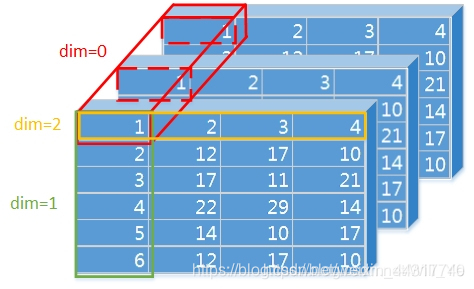torch.nn.functional.Softmax(input,dim=None)
tf.nn.functional.softmax(x,dim)中的参数dim是指维度的意思,设置这个参数时会遇到0,1,2,-1等情况。

一般会有设置成dim=0,1,2,-1的情况。
准备工作:先随机生成一个(2,2,3)的矩阵,两个维度的(2,3)矩阵。
import torch
import torch.nn.functional as F
input = torch.randn(2,2,3))
print(input)
输出为:
tensor([[[-3.9332, 0.7909, 0.8927],
[-1.7991, 0.2505, 0.7695]],
[[ 0.1946, 0.1878, 1.2713],
[ 0.9536, 1.0525, -0.7081]]])
dim=0是对每一维度相同位置的数值进行softmax运算
例如:
m = F.softmax(input,dim=0)
print(m)
输出为:
tensor([[[0.0159, 0.6464, 0.4065],
[0.0599, 0.3096, 0.8142]],
[[0.9841, 0.3536, 0.5935],
[0.9401, 0.6904, 0.1858]]])
从输出结果可以看出,一共2个维度
每一个维度(2,3)对应的数值相加为1,例如:
[0][0][0]+[1][0][0]=0.0159+0.9841=1
[0][0][1]+[1][0][1]=0.6464+0.3536=1
dim=1是对某一维度的列进行softmax运算
m = F.softmax(input,dim=1)
print(m)
输出为:
tensor([[[0.1058, 0.6319, 0.5308],
[0.8942, 0.3681, 0.4692]],
[[0.3189, 0.2964, 0.8786],
[0.6811, 0.7036, 0.1214]]])
从输出结果可以看出,计算的是某一维度中的列,例如:
在第1维度中:
[0][0][0]+[0][1][0]=0.1058+0.8942=1
在第2维度中:
[1][0][0]+[1][1][0]=0.3189+0.6811=1
dim=2是对某一维度的行进行softmax运算
m = F.softmax(input,dim=2)
print(m)
输出为:
tensor([[[0.0042, 0.4726, 0.5232],
[0.0458, 0.3560, 0.5982]],
[[0.2029, 0.2015, 0.5955],
[0.4360, 0.4813, 0.0828]]])
从输出结果可以看出,计算的是某一维度中的行,例如:
在第1维度中:
[0][0][0]+[0][0][1]+[0][0][2]=0.0042+0.4726+0.5232=1
在第2维度中:
[1][0][0]+[1][0][1]+[1][0][2]=0.2029+0.2015+0.5955=0.9999=1(是等于1的,只是后面还有很多位小数省略了)
dim=-1是对某一维度的行进行softmax运算
从这里可以发现,dim=-1和dim=2的结果是一样的。
总结:
用一张图片会更好理解这个参数数值变化代表的意思:






 本文详细解析了PyTorch中Softmax函数的使用方法,通过实例演示了不同维度设置下Softmax运算的过程及结果,帮助读者深入理解该函数的工作原理。
本文详细解析了PyTorch中Softmax函数的使用方法,通过实例演示了不同维度设置下Softmax运算的过程及结果,帮助读者深入理解该函数的工作原理。
















 1346
1346

 被折叠的 条评论
为什么被折叠?
被折叠的 条评论
为什么被折叠?








